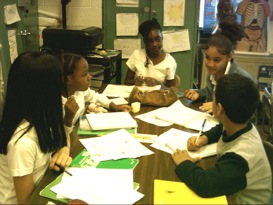
Classroom Discourse & Communities-of-practice


The Role of Discourse and Identity in Science Learning
Integral to science learning are the Discourses that youth draw upon in their everyday and academic lives. Discourses are ways of knowing, doing, talking, interacting, valuing, thinking, believing, reading, writing and representing oneself that are “always and everywhere social,” produced and reproduced in social and cultural practices and interactions (Gee, 1996; Heath, 1983). Drawing on the interconnectedness of youths’ cultures and the Discourses they draw upon to make sense of their worlds, Discourses can also be understood as reflections of youths’ identities (Gee, 1999).If the Discourses that youth, or in our case girls, draw upon in their lives can be understood as reflections of their identities then their knowledges, behaviors, conventions, activities and beliefs—who they are—always embedded in social hierarchies and reflective of the distribution of power, are constantly shaping how and why science is done. 

Communities of Practice
Lave and Wenger’s (1991) framework of situated cognition emphasizes the link between learning and identity formation. Learning is viewed as legitimate peripheral participation where new members are inducted into a community of practice as apprentices. Therefore, to learn in that community means to become “a different person with respect to the possibilities enabled by these systems of relations” (p. 53). In other words, students are crafting identities and developing certain ways of being in the science classroom while engaging in activities and tasks and in relating to the teacher and their peers. Moving towards full membership entails “an increasing sense of identity as a master practitioner” (p.111). Learning science is thus manifested through the transformation of “identity-in-practice” in the science classroom.
Papers:
1.Tan, E. & Calabrese Barton, A. (2006). Understanding How Girls’ Identities Shape Their Science Practices: The Stories of Amelia and Ginny. A paper presented at the National Association for Research in Science Teaching. San Francisco, CA. (download) (Videos)
2. Groome, M., Calabrese Barton, A., & Rivet, A. (2006). On the Edge: Two Girls Negotiate Participation in a Middle School Science Classroom. A paper presented at the National Association for Research in Science Teaching. San Francisco, CA. (download)
3. Rivet, A., & Calabrese Barton, A. (2006). Urban Girls’ Science Practices: Implications for Classroom Instruction. A paper presented at the National Association for Research in Science Teaching. San Francisco, CA.